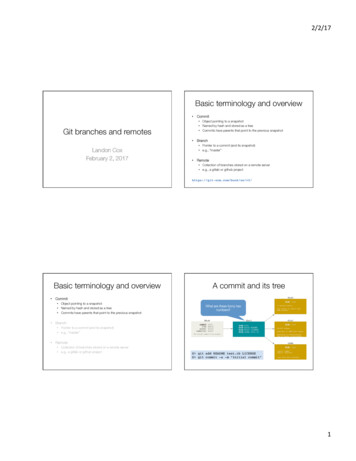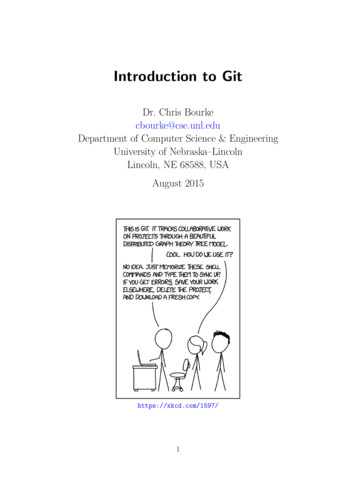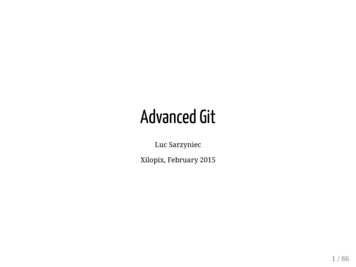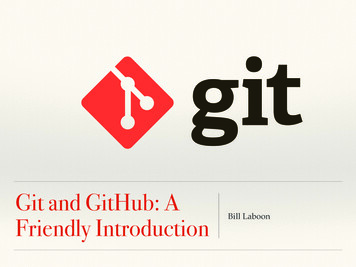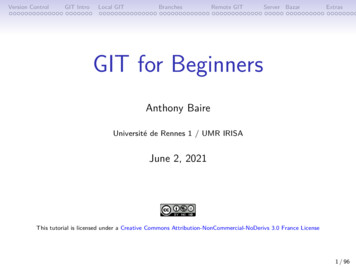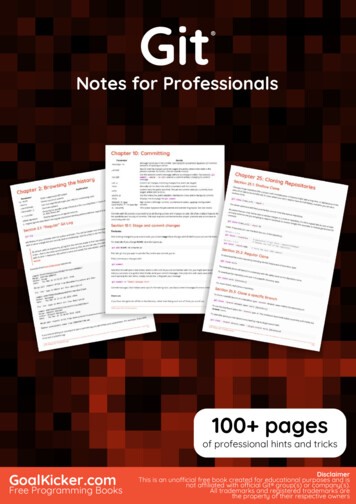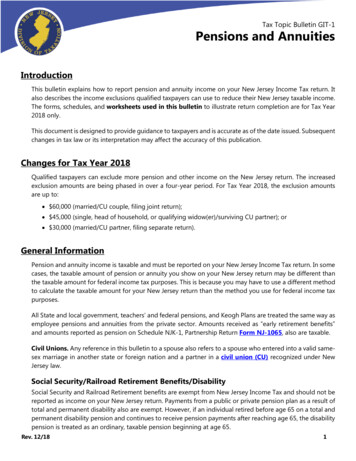
Transcription
Tax Topic Bulletin GIT-1Pensions and AnnuitiesIntroductionThis bulletin explains how to report pension and annuity income on your New Jersey Income Tax return. Italso describes the income exclusions qualified taxpayers can use to reduce their New Jersey taxable income.The forms, schedules, and worksheets used in this bulletin to illustrate return completion are for Tax Year2018 only.This document is designed to provide guidance to taxpayers and is accurate as of the date issued. Subsequentchanges in tax law or its interpretation may affect the accuracy of this publication.Changes for Tax Year 2018Qualified taxpayers can exclude more pension and other income on the New Jersey return. The increasedexclusion amounts are being phased in over a four-year period. For Tax Year 2018, the exclusion amountsare up to: 60,000 (married/CU couple, filing joint return); 45,000 (single, head of household, or qualifying widow(er)/surviving CU partner); or 30,000 (married/CU partner, filing separate return).General InformationPension and annuity income is taxable and must be reported on your New Jersey Income Tax return. In somecases, the taxable amount of pension or annuity you show on your New Jersey return may be different thanthe taxable amount for federal income tax purposes. This is because you may have to use a different methodto calculate the taxable amount for your New Jersey return than the method you use for federal income taxpurposes.All State and local government, teachers’ and federal pensions, and Keogh Plans are treated the same way asemployee pensions and annuities from the private sector. Amounts received as “early retirement benefits”and amounts reported as pension on Schedule NJK-1, Partnership Return Form NJ-1065, also are taxable.Civil Unions. Any reference in this bulletin to a spouse also refers to a spouse who entered into a valid samesex marriage in another state or foreign nation and a partner in a civil union (CU) recognized under NewJersey law.Social Security/Railroad Retirement Benefits/DisabilitySocial Security and Railroad Retirement benefits are exempt from New Jersey Income Tax and should not bereported as income on your New Jersey return. Payments from a public or private pension plan as a result oftotal and permanent disability also are exempt. However, if an individual retired before age 65 on a total andpermanent disability pension and continues to receive pension payments after reaching age 65, the disabilitypension is treated as an ordinary, taxable pension beginning at age 65.Rev. 12/181
Pension and AnnuitiesMilitary PensionsIf you are receiving a U.S. military pension or survivor’s benefit payments, the military pension or survivor’sbenefit is exempt from New Jersey Income Tax regardless of your age or disability status. Do not include suchpayments on your New Jersey return. Military pensions are those resulting from service in the Army, Navy,Air Force, Marine Corps, or Coast Guard. This exemption does not apply to civil service pensions or annuities,even if the pension or annuity is based on credit for military service. Most military pensions and survivor’sbenefit payments are received from the U.S. Defense Finance and Accounting Service, while a civil serviceannuity is received through the U.S. Office of Personnel Management. For more information on militarypensions, see Tax Topic Bulletin GIT-7, Military Personnel and Families.Individual Retirement Arrangements (IRAs)An IRA is a personal savings plan in which you set aside money for retirement. Taxable amounts withdrawnfrom an IRA are reported on the same line of the New Jersey tax return as taxable pensions and annuities.Residents also should report the excludable amount on the same line as excludable pensions and annuities.If you receive payments from an IRA, see Tax Topic Bulletin GIT-2, IRA Withdrawals, for information on howto calculate the taxable and excludable portions of the withdrawal for your New Jersey Income Tax return.For information on Roth IRAs, see Technical Bulletin TB-44. The methods described here relate only tocalculating the taxable and excludable portions of a withdrawal from a pension or annuity – not for an IRAwithdrawal. Do not use them to calculate the tax consequences of an IRA withdrawal.Part-Year ResidentsAny person who became a resident of New Jersey or who moved out of this state during the year is considereda part-year resident. A part-year resident files a New Jersey Income Tax resident return that covers the periodof residence in New Jersey and reports only the income he or she earned or received while a resident here.Part-year residents must prorate all exemptions, deductions, credits, and exclusions (including the pensionand other retirement income exclusions) to reflect the period covered by the return. For more information,see Tax Topic Bulletin GIT-6, Part-Year Residents.NonresidentsPension and annuity income received by a nonresident for work performed in New Jersey is not taxable underthe New Jersey Gross Income Tax Act. If your only income from New Jersey sources is pension or annuityincome, you do not need to file a New Jersey nonresident return. However, if you have other income fromNew Jersey that is taxable to a nonresident (e.g., wages, business income, gain from the sale of real propertyin New Jersey), you are required to file a New Jersey Income Tax Nonresident Return (Form NJ-1040NR).Report any pension or annuity income in Column A along with your other taxable income.Withholding Tax and Estimated TaxNew Jersey residents who receive pension or annuity income can ask the payer to withhold New JerseyIncome Tax from these payments. If you want to have New Jersey Income Tax withheld, complete the NJ-W4-P, Certificate of Voluntary Withholding of New Jersey Gross Income Tax From Pension and AnnuityPayments. Indicate the amount of tax to be withheld, and give it to the payer of the pension or annuity.Rev. 12/182
Pension and AnnuitiesFederal civilian retirees can elect to have New Jersey Income Tax withheld from their federal pensionpayments. Federal retirees who want to take advantage of this option should call the U.S. Office of PersonnelManagement, the agency that oversees federal pensions, at 1-888-767-6738 or visit here. Voluntary NewJersey withholdings also are permitted for retirees from the uniformed services.Individuals who expect their New Jersey Income Tax liability to be more than 400 after taking into accountall their exemptions, deductions, withholdings, and other credits for the tax year are required to makequarterly estimated tax payments. This requirement may affect taxpayers who do not have New Jersey IncomeTax withheld from their wages and/or pension, those who are self-employed, or those whose income is fromsources such as interest, dividends, or capital gains, which are not covered by withholding tax. Use Form NJ1040-ES to file estimated tax payments when due. For more information on estimated tax payments, see TaxTopic Bulletin GIT-8, Estimating Income Taxes.RecordkeepingKeeping records will help you prepare a complete and accurate tax return and pay the correct amount ofNew Jersey tax on income from your pension, annuity, or IRA.Contributions. It is very important to keep any statements that show your contributions to your pension,annuity, or IRA. You will need this information when you start to withdraw money from the plan. You mayhave to pay more tax if you do not know the amount of your contributions on which New Jersey Income Taxhas already been paid. If you do not have a record of your contributions, you must contact the payer of thepension or annuity to get that information.Income Statements. Keep all the statements from your pension, annuity, or IRA showing the amounts youhave received from the plan. These include Forms W-2P and 1099-R.Tax Returns and Worksheets. Keep copies of the tax returns you have filed and the Income Tax instructionbooklet as part of your records. You may need information from the return or from the worksheets in theinstruction booklet to prepare future tax returns. This information also is necessary if you file an amendedreturn. Copies of your returns and other records can be helpful to your surviving spouse or theexecutor/administrator of your estate.Rev. 12/183
Pension and AnnuitiesCalculating Taxable and Excludable AmountsPensions and annuities fall into one of two categories: noncontributory or contributory. A noncontributoryplan is one to which an individual has not made contributions. A contributory plan is one to which anindividual has made contributions. The taxable amount you report on your New Jersey Income Tax return willdepend on whether the pension or annuity payment came from a contributory or a noncontributory plan.Noncontributory PlansNoncontributory plans do not require an employee to make contributions. Payments you receive from sucha plan are fully taxable because you have never paid tax on any of the funds in the plan. You will report onyour New Jersey Income Tax return the total amount of pension or annuity income shown on the Form 1099R you receive from the payer of the pension or annuity.Contributory PlansContributory pension plans are structured in such a way that an employee contributes money at set intervalsand collects an annual pension upon retirement. In most cases, pension contributions are made throughsalary deduction and are included in the employee’s income when the contributions are made.The total value of the pension or annuity consists of your contributions, your employer’s contributions, if any,and earnings. In general, your personal contributions to the pension or annuity are taxed when they aremade. Those contributions, once taxed, will not be taxed again by New Jersey. Therefore, the part of a pensionor annuity payment that represents a return of contributions that already have been taxed is excludable. Itshould not be reported as taxable income on Line 19a, Form NJ-1040 or on Line 21, Column A, Form NJ1040NR. However, any amounts you receive in excess of your previously taxed contributions must bereported as taxable income.You must determine the taxable portion (and the excludable portion if you are a resident) of payments youreceive from a pension or annuity to which you have made contributions. For New Jersey purposes, you willuse either the Three-Year Rule Method or the General Rule Method to calculate these amounts. To determinewhich method you should use, complete Worksheet A. If you do not use the correct method to determinethe taxable and excludable portions of your pension or annuity, you may owe additional tax, penalty, andinterest.Note: If your retirement account is a 401(k) plan, review the information on Section 401(k) Plans beforecontinuing.Rev. 12/184
Pension and AnnuitiesWorksheet AWhich Pension Method to Use1. Amount of pension you will receive during the first three years(36 months) from the date of the first payment . 1.2. Your contributions to the plan . 2.3. Subtract line 2 from line 1. 3.(a) If line 3 is “0” or more, and both you and your employer contributedto the plan, you can use the Three-Year Rule Method.(b) If line 3 is less than “0,” or your employer did not contribute tothe plan, you must use the General Rule Method.(Keep for your records)Three-Year Rule MethodThere are two methods you can use to calculate taxable pension income: Three-Year Rule Method andGeneral Rule Method. If you use the Three-Year Rule Method, your pension is not reported as taxable incomeuntil the payments you receive from the plan equal the amount you contributed. Use the Three-Year RuleMethod to determine your New Jersey taxable and excludable pension income if:1. You will receive an amount equal to or greater than your pension and annuity contributions within threeyears (36 months) from the date you receive your first payment from the plan; and2. Your employer contributed to the plan.When using the Three-Year Rule Method, you should exclude pension and annuity payments from taxableincome until the payments received equal the amount you contributed to the plan. This will not necessarilybe a full 36 months. Until that time, the amounts you receive, because they are considered contributions, arenot taxable and should not be reported as taxable income on your New Jersey return. However, residentsmust report these excludable amounts on Line 20b, Form NJ-1040. The nonresident return does not have aline for reporting the excludable portion of pension and annuity payments.Once you have received (recovered) an amount equal to the amount you contributed to the pension orannuity, all amounts you receive are fully taxable. (See example.)Note: The Three-Year Rule Method was repealed for federal income tax purposes. If you are using the ThreeYear Rule Method for New Jersey Income Tax purposes, the amount of taxable pension or annuityyou report on your New Jersey return will be different than the taxable amount on your federal return.Rev. 12/185
Pension and AnnuitiesGeneral Rule MethodIf you use the General Rule Method, part of your pension or annuity payment is taxable and part is excludedfrom your income every year. You must use the General Rule Method to determine New Jersey taxablepension income when:1. You will not recover all your personal contributions within three years (36 months) from the date youreceive your first payment from the plan; or2. Your employer did not contribute to the plan.Worksheet BGeneral Rule Method1. Your previously taxed contributions to the plan . 1.2. Expected return on contract* . 2.3. Percentage excludable (Divide line 1 by line 2) . 3. %4. Amount received this year . 4.5. Amount excludable (Multiply line 4 by line 3.Enter here and on Line 20b, Form NJ-1040) . 5.6. Taxable amount (Subtract line 5 from line 4.Enter here and on Line 20a, Form NJ-1040) . 6.*The expected return on the contract is the amount receivable. If life expectancy is afactor under your plan, you must use federal actuarial tables to calculate the expectedreturn. The federal actuarial tables are contained in the Internal Revenue Service’sPublication 939, General Rule for Pensions and Annuities. Contact the IRS for thispublication. If life expectancy is not a factor under your plan, the expected return isfound by totaling the amounts to be received.(Keep for your records)When you use the General Rule Method, in the first year and every year thereafter, part of your pension orannuity payment will be excludable (the portion of that year’s distribution that represents your contributions)and part will be taxable. Use Worksheet B to determine the taxable portion and the excludable portion ofyour pension or annuity payment.Rev. 12/186
Pension and AnnuitiesExampleJames Henderson, a New Jersey resident, retired and began to receive an annual pension of 7,000. Hecontributed 20,000 to his pension, and his employer also contributed. James can use the Three-Year RuleMethod to calculate the taxable amount of his pension income because the amount he will have receivedwithin 36 months from the date of the first payment ( 21,000) exceeds the amount of his contributions( 20,000) by 1,000 (see line 3 of worksheet), and his employer also contributed to the plan.Worksheet AWhich Pension Method to Use1. Amount of pension you will receive during the first three years(36 months) from the date of the first payment . 1.21,0002. Your contributions to the plan . 2.20,0003. Subtract line 2 from line 1 . 3.(a) If line 3 is “0” or more, and both you and your employer contributedto the plan, you can use the Three-Year Rule Method.(b) If line 3 is less than “0,” or your employer did not contribute tothe plan, you must use the General Rule Method.1,000(Keep for your records)When using the Three-Year Rule Method, Mr. Henderson will exclude the pension payments he receives fromhis New Jersey income until he has recovered an amount equal to his contributions. Then his pensionpayments become fully taxable. He will report his pension as follows:RecoveryPeriodYear 1Year 2Year 3Year 4 and afterTaxablePension 001,0007,000ExcludablePension 7,0007,0006,0000If Mr. Henderson were a nonresident, he would not report the excludable portion of his pension payment onForm NJ-1040NR, only the taxable portion.Remember when completing your tax return that the recovery period described above begins with the dateof the first pension payment. The “first year,” “second year,” etc., cannot correspond with the beginning ofthe taxable year.If a taxpayer will not recover all personal contributions within three years (36 months) from the date of thefirst payment from the plan, or if the employer did not contribute to the plan, then the General Rule Methodmust be used to determine the taxable amount of pension for New Jersey Income Tax purposes.Rev. 12/187
Pension and AnnuitiesTherefore, if James Henderson’s contributions to his pension plan were 20,000 and his annual pensionamount 4,000, he would have to use the General Rule Method because he would not recover an amountequal to his contributions within 36 months after the first payment. Using Worksheet B, he would calculatethe percentage of his pension payment that is excludable from New Jersey income each year.Contributions Prior to ResidenceAny contributions you made to a pension or annuity before you moved to New Jersey are treated in the sameway they would have been treated if you had been living in New Jersey at the time you made thecontributions. Contributions to plans other than 401(k) Plans are considered to have been previously taxed.Use the appropriate method to determine the taxable and excludable amounts to report on your New Jerseyreturn.Section 401(k) PlansBeginning on January 1, 1984, New Jersey’s treatment of 401(k) Plan contributions changed. After that date,employee contributions to 401(k) Plans were no longer included in taxable wages when earned. If you madecontributions to a 401(k) Plan before January 1, 1984, your distribution will be treated differently than if allthe contributions were made after this date.1. All contributions made on or after January 1, 1984. If all contributions to your 401(k) Plan were madeon or after January 1, 1984, they were not included in income when they were made, unless thecontributions exceeded the federal elective deferral limit. As a result, distributions from the plan are fullytaxable.2. Contributions made before January 1, 1984. Contributions to a 401(k) Plan made before January 1,1984, were included in an employee’s income when they were made. If you made contributions to a 401(k)Plan before January 1, 1984, or you made contributions beyond the federal limit, you will calculate thetaxable portion and the excludable portion of your distribution by using either the Three-Year RuleMethod or the General Rule Method, whichever is appropriate.Section 457 PlansIf you participated in an eligible deferred compensation plan of a state or local government or tax exemptorganization (Section 457), your contributions to the plan were included in your New Jersey income whenthey were made. When you retire, you will only be taxed on amounts you receive in excess of thosecontributions.1. Tax years ending before January 1, 2002. For tax years ending before January 1, 2002, distributions ofdeferred pay were treated as wages and reported on Line 14, Form NJ-1040 (or on the “wages” line inColumn A, Form NJ-1040NR*). Taxpayers used the “State wages” figure from the W-2 form they receivedfrom the Section 457 Plan, which in most cases was different from the “federal wages” amount.2. Tax years beginning on or after January 1, 2002. For tax years beginning on and after January 1, 2002,the federal reporting document for Section 457 Plan distributions for State and local governmentemployees changed from federal Form W-2 to Form 1099-R. Distributions from a Section 457 Plan ofamounts in excess of previously taxed contributions are treated as pension payments and should bereported on Line 20a, Form NJ-1040 (or Line 22, Column A, Form NJ-1040NR). See Calculating TaxableRev. 12/188
Pension and Annuitiesand Excludable Amounts for information on how to determine the taxable portion and the excludableportion of your payment.Section 457 Plan distributions to nongovernmental employees continue to be reported on federal Form W2. Such taxpayers should use the “State wages” figure from the W-2 they receive on the “wages” line of FormNJ-1040 (or on the “wages” line in Column A, Form NJ-1040NR*).*Distributions received from a Section 457 Plan by a nonresident that are reported on Form W-2 are notsubject to New Jersey Income Tax, and should not be reported on the “wages” line in Column B, FormNJ-1040NR. They do not have to be reported if: such income was part of a series of substantially equalperiodic payments (not less frequently than annually); made for the life or life expectancy of the recipient (orthe joint lives or joint life expectancies of the recipient and the designated beneficiary of the recipient); or fora period of not less than 10 years, or if payment was received from a retirement benefit plan after terminationof employment.Section 403(b) PlansIf you participated in a 403(b) plan, your contributions to the plan were included in your New Jersey incomewhen they were made. When you retire, you will only be taxed on amounts you receive in excess of thosecontributions.Postretirement Contributions. If your employer makes a contribution to your 403(b) plan after you retire,the contribution is taxable for New Jersey Income Tax purposes and must be reported as wages on your NewJersey Income Tax return in the year(s) that the contribution is made. Such postretirement contributions,which have already been taxed by New Jersey, must be taken into account when determining the taxableamount and the excludable amount of any distribution from the 403(b) plan. (See Calculating Taxable andExcludable Amounts.)Lump-Sum Distributions and RolloversWhen you receive a lump-sum distribution of the entire balance from a qualified employee pension, annuity,profit-sharing, or other plan, the amounts you receive that are in excess of your previously taxed contributionsto the plan must be included in income in the year you receive them. New Jersey has no provisions for incomeaveraging of lump-sum distributions. Residents also must report the excludable portion of the distributionon Line 20b, Form NJ-1040.A lump-sum distribution that you roll over (transfer) into a traditional IRA or other eligible plan should notbe reported on your New Jersey return if the rollover qualifies for deferral for federal income tax purposes.The amount rolled over (minus previously taxed amounts) is taxable later when it is withdrawn. As underfederal law, the rollover must be made within the 60-day period after distribution. For more information, seeTax Topic Bulletin GIT-2, IRA Withdrawals.If you convert a traditional IRA into a Roth IRA, any amount from the existing IRA that would be taxable ifwithdrawn must be included in your income. Residents also must report the excludable portion of theconverted IRA on Line 20b, Form NJ-1040.Rev. 12/189
Pension and AnnuitiesSurvivors and BeneficiariesIn general, pension and annuity income received by a survivor or beneficiary is treated the same way asregular pension or annuity income. Amounts received, whether in the form of periodic payments or in a lumpsum, are taxable to the extent that they exceed the decedent’s previously taxed contributions to the plan.Upon the death of the owner of the pension or annuity, the amount paid to the surviving beneficiary is taxableto the extent that it exceeds the surviving beneficiary’s contribution to the plan. The surviving beneficiary’scontribution is determined as follows:1. When the distribution to the surviving beneficiary is subject to taxation by the New Jersey TransferInheritance Tax Act,* the contribution of the surviving beneficiary is the value of the annuity, pension, orretirement benefits as determined for Transfer Inheritance Tax purposes. The recipient can exclude fromIncome Tax the amount that represents the contribution, which is the value determined for TransferInheritance Tax purposes. Consult the Tax Guide on being an Executor for more details.2. When the beneficiary receives benefits that are not subject to Transfer Inheritance Tax, he or she is entitledto exclude from income the remaining previously taxed contributions of the decedent. If the decedent’scontributions to the plan have already been recovered, all pension income received by the beneficiary istaxable and must be included in income.*Property inherited from a spouse who died on or after January 1, 1985, is not subject to Inheritance Tax.Transfers to parents, grandparents, children, or grandchildren of decedents who died on or after July 1, 1988,also are not subject to Inheritance Tax. In addition, transfers to qualified domestic partners of decedentswho died on or after July 10, 2004, are not subject to Inheritance Tax. Finally, transfers to a civil union partnerfrom a decedent who died on or after February 19, 2007, are not subject to Inheritance Tax. Contact theDivision’s Inheritance Tax Section at 609-292-5033 for more information.Income ExclusionsNew Jersey tax law provides the following retirement income exclusions to enable you to reduce your taxableincome: pension exclusion and the other retirement income exclusion, which includes the unclaimed pensionexclusion and the special exclusion. The unclaimed pension exclusion is the unclaimed portion of the pensionexclusion, and the special exclusion is for taxpayers who cannot receive Social Security or Railroad Retirementbenefits. The exclusions are not a one-time benefit. You can use the exclusions on your New Jersey IncomeTax return every year you qualify. Both residents and nonresidents can take advantage of the retirementincome exclusions if they meet the qualifications.Pension ExclusionTaxpayers who qualify can exclude all or a part of the income received during the year from taxable pensions,annuities, and IRA withdrawals.You qualify for the New Jersey pension exclusion if:1. You (and/or your spouse/civil union partner, if filing jointly) were 62 or older or disabled as defined bySocial Security guidelines on the last day of the tax year (December 31 for calendar year filers); and2. Your total income for the entire year was 100,000 or less.Rev. 12/1810
Pension and AnnuitiesIf you qualify, the pension exclusion amount you can claim for Tax Year 2018 is the lesser of:1. Your actual taxable pension income; or2. The maximum pension exclusion amount for your filing status: 60,000 Married/CU couple, filing joint return 45,000 Single; Head of household; Qualifying widow(er)/Surviving CU partner 30,000 Married/CU partner,Report your taxable pension income amount on Line 20a, Form NJ-1040 (Line 22, Column A, Form NJ1040NR) and the allowable pension exclusion amount on Line 28a, Form NJ-1040 (Line 28a, Column A, FormNJ-1040NR).Note: The pension exclusion used can never be more than your actual taxable pension income amount.Remember, part-year residents must prorate the pension exclusion amount by the number of monthsspent as a New Jersey resident. See Tax Topic Bulletin GIT-6, Part-Year Residents, for moreinformation.If you (and/or your spouse) were 62 or older on the last day of the tax year and you did not use themaximum pension exclusion amount for your filing status, or you did not use the pension exclusionbecause you did not report any taxable pension, annuity, or IRA withdrawal income on Line 20a, FormNJ-1040 or Line 22, Column A, Form NJ-1040NR, you may still qualify for other exclusions. (See OtherRetirement Income Exclusion: Unclaimed Pension Exclusion and Special Exclusion.)ExampleJohn and Linda Harris are both 63 years old and file a joint return. Their combined total income is 66,000for the tax year. Their combined taxable pension income totals:Actual Taxable Pension IncomeApplicable Pension Exclusion 62,000 60,000ExampleHenry Norton is 59 years old. He is single and not disabled. His total income for the tax year is 45,000. Hereceives a taxable pension of 7,000 and 303 of his IRA withdrawal is taxable.Actual Taxable Pension IncomeApplicable Pension Exclusion 7,303 0Henry is not eligible to claim the pension exclusion because he is under age 62 and not disabled.ExampleAlejandro and Maria Rivera file a joint return and both qualify for the pension exclusion. They have acombined total income of 75,000 for the tax year. Mr. Rivera receives an annual taxable pension of 61,500,Rev. 12/1811
Pension and Annuitiesand Mrs. Rivera receives a 2,500 pension. She reports 0 as taxable income this year because she is usingthe Three-Year Rule Method and is still recovering her contributions.Actual Taxable Pension IncomeApplicable Pension Exclusion 61,500 60,000ExampleTyrone and Shanequa Jackson are both age 67 and file a joint return. They have a combined total income of 110,450 for the tax year, including taxable pension income of 79,000.Actual Taxable Pension IncomeApplicable Pension Exclusion 79,000 0The Jacksons are not eligible for a pension exclusion
This bulletin explains how to report pension and annuity income on your New Jersey ncome Tax return. It I . pension is treated as an ordinary, taxable pension beginning at age 65. Pension and Annuities Rev. 12/18 2. . instruction booklet to prepare future tax returns. This information also is necessary if you file an amended


